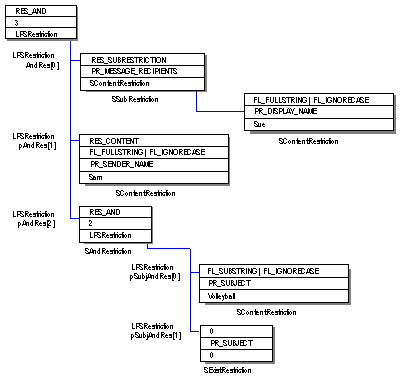
| Platform SDK: MAPI |
To build a restriction, a client application creates a hierarchy of one or more restriction structures of various types and passes a pointer to the hierarchy to the IMAPITable::Restrict or IMAPITable::FindRow method. The illustration that follows and the code sample in Sample Restriction Code demonstrate how a typical restriction is implemented with linked restriction structures of different types. In this example, a user of a client application is trying to find all messages that contain the word "volleyball" in the subject line and were sent to Sue from Sam. First, a generic SRestriction structure is allocated. This structure becomes the basis for other calls to the MAPIAllocateMore function to create linked SRestriction and SPropValue structures that can be freed with a single call to MAPIFreeBuffer. Because the criteria to apply to the set of messages is in three parts, the top level restriction structure is an AND restriction. The SAndRestriction structure's cRes member is set to 3 to indicate the three restrictions to evaluate and its lpRes member is set to a three member array of SRestriction structures.
To search for messages that are sent to a particular recipient, it is necessary to search the recipient table for each message rather than the message itself. A subobject restriction is used to perform the recipient table search. Therefore, the first member of the array points to an SSubRestriction structure with its ulSubObject member set to PR_MESSAGE_RECIPIENTS. Then, to specify what to look for in the recipient table, a content restriction is used.
The second and third members of the array are more straightforward. They both point to content restriction structures, one to search for messages that have a PR_SENDER_NAME property set to "Sam" and another that has a PR_SUBJECT property set to "volleyball."
